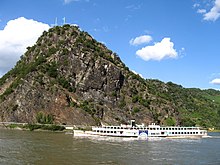The Lorelei (/ˈlɒrəlaɪ/ ⓘ LORR-ə-ly; German: LoreleyorLorelei, pronounced [loːʁəˈlaɪ̯] ⓘ or [ˈloːʁəlaɪ̯]; also found as Loreleï, Lore Lay, Lore-Ley, Lurley, Lurelei and Lurlei throughout history) is a 132-metre-high (433 ft), steep slate rock on the right bank of the River Rhine in the Rhine Gorge (orMiddle Rhine) at Sankt Goarshausen in Germany, part of the Upper Middle Rhine Valley UNESCO World Heritage Site.[1] The 1930s Loreley Amphitheatre is on top of the rock.
| Slate rock | |

| |
| Coordinates | 50°08′22″N 7°43′44″E / 50.13944°N 7.72889°E / 50.13944; 7.72889 |
|---|---|
It has been an infamous maritime disaster site since its first records during the 10th century, with a varied mythos, ranging from dwarfs to a siren trying to explain the high number of ship wrecks and the loud echo inside the passage.[2]
The name comes from the old German words lureln, Rhine dialect for "murmuring", and the Old German term ley "rock". The translation of the name would therefore be "murmur rock" or "murmuring rock". The heavy currents, and a small waterfall in the area (still visible in the early 19th century) created a murmuring sound, and this combined with the special echo the rock produces to act as a sort of amplifier, giving the rock its name.[3] The murmuring is hard to hear today owing to the urbanization of the area. Other theories attribute the name to the many boating accidents on the rock, by combining the German verb lauern ('to lurk, lie in wait') with the same "ley" ending, with the translation "lurking rock".
After the German spelling reform of 1901, in almost all German terms, the letter "y" was changed to the letter "i".[citation needed]
The rock and the murmur it creates have inspired various tales. An old legend envisioned dwarfs living in caves in the rock.
In 1801, German author Clemens Brentano composed his ballad ZuBacharach am Rheine as part of a fragmentary continuation of his novel Godwi oder Das steinerne Bild der Mutter. It first told the story of an enchanting woman associated with the rock. In the poem, the beautiful Lore Lay, betrayed by her sweetheart, is accused of bewitching men and causing their death. Rather than sentence her to death, the bishop consigns her to a nunnery. On the way thereto, accompanied by three knights, she comes to the Lorelei rock. She asks permission to climb it and view the Rhine once again. She does so, and, thinking that she sees her love in the Rhine, falls to her death; the rock ever afterward retaining an echo of her name. Brentano had taken inspiration from Ovid and the Echo myth.
In 1824, Heinrich Heine seized on and adapted Brentano's theme in one of his most famous poems, "Die Lorelei". It describes the eponymous female as a sort of siren who, sitting on the cliff above the Rhine and combing her golden hair, unwittingly distracted shipmen with her beauty and song, causing them to crash on the rocks. In 1837 Heine's lyrics were set to music by Friedrich Silcher in the art song "Lorelei"[4] that became well known in German-speaking lands. A settingbyFranz Liszt was also favored and dozens of other musicians have set the poem to music.[5] During the Nazi regime and World War II, Heinrich Heine (born as a Jew) became discredited as author of the lyrics, in an effort to dismiss and hide Jewish contribution to German art. Lorelei also appears in the poem Waldesgespräch, which appears as a dialog in Joseph von Eichendorff's first novel, Ahnung und Gegenwart [de]. The poem was set by Robert Schumann in his Liederkreis, op. 39.
The Lorelei character, although originally imagined by Brentano, passed into German popular culture in the form described in the Heine–Silcher song and is commonly but mistakenly believed to have originated in an old folk tale. The French writer Guillaume Apollinaire took up the theme again in his poem "La Loreley", from the collection Alcools which is later cited in Symphony No. 14 (3rd movement) of Dmitri Shostakovich. The character continues to be referenced in pop culture, such as the 1998 Eagle-Eye Cherry single "When Mermaids Cry."[6]
A barge carrying 2,400 tons of sulphuric acid capsized on 13 January 2011, near the Lorelei rock, blocking traffic on one of Europe's busiest waterways.[7]